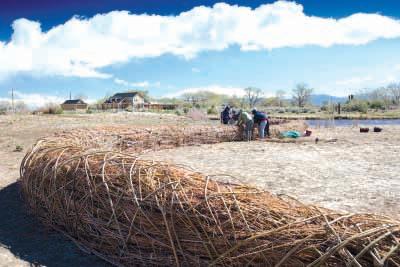
3 minute read
Green
from May 1, 2014
photo/the Nature Co N servaNCy a N d s imo N Williams Employees from Harrah’s Reno and Harvey’s Lake Tahoe worked on the sculpture at River Fork Ranch.
The art of flood relief
Advertisement
Natural material sculptures to help river restoration
Native willows woven together to form 340-feet-long, thick, almost rope-like sculptures are being created in floodplains of the Carson River and—in the fall—of the Truckee River to help enhance the riparian habitats and direct floodwaters. by The Nature Conservancy (TNC) has partnered with the Nevada Museum
Sage Leehey of Art and two environmental artists from San Francisco, Mary O’Brien and sagel@ Daniel McCormick, for this project. One sculpture will be at the River Fork newsreview.com Ranch Preserve in the Carson Valley, and the other will be at the McCarran Ranch Preserve on the Truckee just east of Reno. The Carson River project is currently underway and will be completed by the end of May, and the Truckee River project will take place in the fall. “The sculpture [at River Fork Ranch] will actually serve as speed bumps to slow down floodwaters through that area, allowing the water to sink into the ground and recharge the natural aquifer,” said TNC Eastern Sierra Nevada program project director, Duane Petite. “It will also filter pollutants, things that might run off the nearby road or off agricultural fields. … It’s going to reduce bank erosion, so it’ll keep sediment out of the water.” Because the sculptures are made of native willow and will have living willows planted in them as well, it will greatly change these floodplains. Native wildlife are expected to benefit from these changes at both preserves. “It’ll create streamside habitat for native birds, such as willow flying catchers, as well as northern leopard frogs and western pond turtles at the River Fork Ranch preserve,” Petite said. TNC planned their restoration work with ecologists and geomorpholothe next public volunteer day is this Friday, may 2, from gists. The sculptures are a piece of the larger restoration plans, but their size and the amount of effort required to construct them is far larger than TNC noon to 4 p.m. if you’d and the artists could accomplish alone. like to participate in “The artists can conceive of it and the Nature Conservancy can help this or later volunteer design it with our science,” Petite said. “But we couldn’t do the work without events, contact duane petite via email at the literally hundreds of volunteers putting in the work to get it done.” dpetite@tnc.org. Petite said this project is exciting because it gets people from different backgrounds together to help complete it. He explained this project as a mix of the interests, passions and strengths of both TNC and the Nevada Museum of Art and pointed to a volunteer day with students from Douglas High School’s art and environmental clubs as an example. “These are groups of students that know each other—they have classes together—but they have different perspectives and different interests and different viewpoints, and here they were, artists and scientists, working together on a project,” Petite said. “And I think those Douglas High School students kind of epitomized the whole project. It’s a blending, if you will, of art and science.” The sculptures will continue to benefit the rivers and floodplains for years into the future, but they will evolve as time—and water—passes. “I think the project really evokes the ever-changing qualities of the natural world,” Petite said. “What we see one day is different than what we’ll see five years down the road. When I think art, I think of something made out of marble or bronze, so that it’s permanent and unchanging. Or maybe it’s a painting that is then carefully placed in a museum and safeguarded, so it’s not changing. But this particular type of art, this ecological type of art is designed to change over time.” Ω
KTMB’S GREAT COMMUNITY CLEANUP

VOLUNTEER AT KTMB.ORG OR CALL 851.5185


Bike to Work, School & Fun
May 10-16, 2014
TRUCKEE MEADOWS
BICYCLE ALLIANCE














